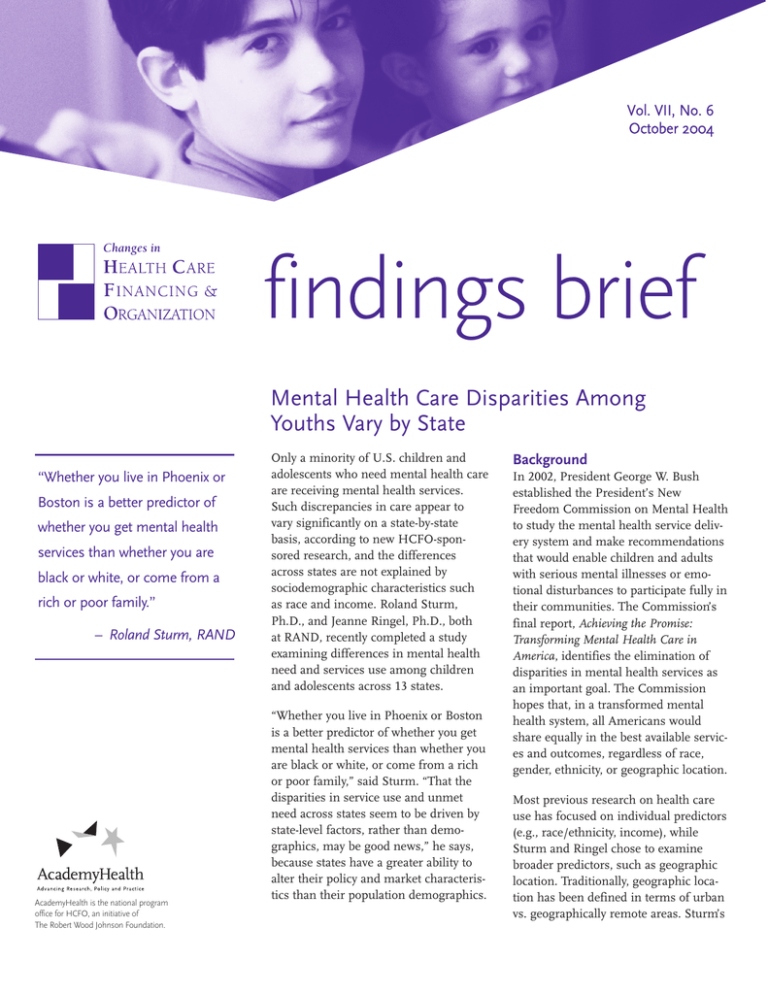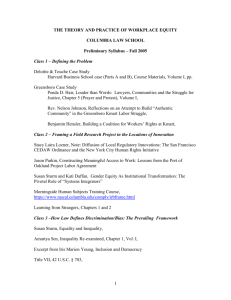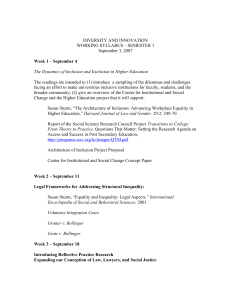findings brief Mental Health Care Disparities Among Youths Vary by State September 2002
advertisement

Vol. VII, No. 6 October 2004 September 2002 Vol. 4 Issue 3 Changes in findings brief Mental Health Care Disparities Among Youths Vary by State “Whether you live in Phoenix or Boston is a better predictor of whether you get mental health services than whether you are black or white, or come from a rich or poor family.” – Roland Sturm, RAND AcademyHealth is the national program office for HCFO, an initiative of The Robert Wood Johnson Foundation. Only a minority of U.S. children and adolescents who need mental health care are receiving mental health services. Such discrepancies in care appear to vary significantly on a state-by-state basis, according to new HCFO-sponsored research, and the differences across states are not explained by sociodemographic characteristics such as race and income. Roland Sturm, Ph.D., and Jeanne Ringel, Ph.D., both at RAND, recently completed a study examining differences in mental health need and services use among children and adolescents across 13 states. “Whether you live in Phoenix or Boston is a better predictor of whether you get mental health services than whether you are black or white, or come from a rich or poor family,” said Sturm. “That the disparities in service use and unmet need across states seem to be driven by state-level factors, rather than demographics, may be good news,” he says, because states have a greater ability to alter their policy and market characteristics than their population demographics. Background In 2002, President George W. Bush established the President’s New Freedom Commission on Mental Health to study the mental health service delivery system and make recommendations that would enable children and adults with serious mental illnesses or emotional disturbances to participate fully in their communities. The Commission’s final report, Achieving the Promise: Transforming Mental Health Care in America, identifies the elimination of disparities in mental health services as an important goal. The Commission hopes that, in a transformed mental health system, all Americans would share equally in the best available services and outcomes, regardless of race, gender, ethnicity, or geographic location. Most previous research on health care use has focused on individual predictors (e.g., race/ethnicity, income), while Sturm and Ringel chose to examine broader predictors, such as geographic location. Traditionally, geographic location has been defined in terms of urban vs. geographically remote areas. Sturm’s findings brief — Changes in Health Care Financing & Organization findings, however, provide a strong argument for expanding the definition of “geographic” disparities more broadly (e.g., on a state-bystate basis). “Perhaps the most disconcerting finding is that the differences in use across states are not paralleled by differences in need.” – Roland Sturm, RAND Methods The researchers used recent data from the National Survey of America’s Families (NSAF), a nationally representative household survey. The sample design of the NSAF allows for state-specific estimates in 13 focus states, which were chosen because they collectively accounted for more than half of the U.S. population, and varied in terms of geographic location, size, demographics, and dominant political tradition. The final sample includes 45,247 children aged 6 to 17. Using these data, the researchers tested for variation across states in four variables: 1) use of any mental health services and number of visits among users; 2) need for mental health care, based on six items from the Child Behavior Checklist; 3) unmet need; and 4) need among users of mental health services. The researchers also examined the intensity of mental health services (e.g., the number of visits among children with at least one visit) among users of mental health care. Unmet need for mental health services was measured by combining indicators for any use and need. Those children who demonstrated a need for mental health services, yet received none, fell into this category. At the state level, this is a measure of how well states target resources to the most needy children. The category of need among users of mental health services comprised children who use mental health services and show a demonstrated need for those services. Findings Use of Mental Health Services The researchers found that the average rate of use of any mental health service ranges from 5 percent in California to 12 percent in Massachusetts; adjusting for age, race/ethnicity, insurance status, and family income did not change the ranking of the states, nor did it reduce the magnitudes of differences across the states. Moreover, 5 of the 13 focus page 2 states included in the NSAF data had rates of use that were significantly different from the national average of 7.5 percent. The findings regarding intensity of care ran counter to the researchers’ hypothesis. “One would expect,” says Sturm, “that, as the percentage of children receiving services increases, less symptomatic children receive some care, and therefore the intensity of services among users declines in areas with higher rates of any service use. But this is not the case—if anything, intensity tends to move more in parallel with rates of any service use.” Mental Health Need Initially, the researchers thought that mental health services may vary across states because the states have differing mental health needs, but this did not appear to be the case. They found that mental health need does not parallel mental health service use variation across states, implying that the states that have the children with the greatest need for mental health services are not necessarily the states with the greatest use of mental health services. “Perhaps the most disconcerting finding is that the differences in use across states are not paralleled by differences in need,” says Sturm. “As a general rule, states with high rates of services do not have low levels of need or vice versa, although that situation does exist.” Massachusetts, for example, had the highest rate of mental health service use at nearly 12 percent, but the estimated need for mental health services among children in Massachusetts is slightly below the national average. Alabama and Mississippi demonstrate the opposite trend: They have lower rates of mental health care service use than the national average, yet higher estimated need. Unmet Need Across states, the rate of unmet need varies from 51.3 percent in Massachusetts to 80.6 percent in California. The researchers found that Hispanic children have the highest unmet need, but that geographic disparities in unmet need exceed the effect of race/ethnicity. findings brief — Changes in Health Care Financing & Organization “A surprising finding is that Mississippi and Alabama, states with high need and low service use, are not in this group (of states with levels of unmet need that are statistically higher than the national average), suggesting that those two states may be more successful in targeting available services to children in need than other states,” says Sturm. Mental Health Need among Service Users The researchers found little variation across states or by race/ethnicity in need among users. However, there are big effects of family income: Children from high-income families receiving mental health care are much less likely to display mental health problems than children in lowincome families. Although there is a strong income effect in need among users, geographic variation plays a larger role in rates of service use and the effectiveness of mental health services. “State differences exist not only in the overall rates of service use but also in how effectively services are delivered to the most needy children,” says Sturm. In ongoing research, Sturm and his colleagues are analyzing state-level variables (e.g., demographic and socioeconomic differences, health care market characteristics, and state-level policies) in an attempt to account for the geographic variation observed in children’s mental health service use and need. They believe that, although states differ substantially in their sociodemographic make-ups, these compositional differences alone do not explain much of the observed geographic variation in mental-healthrelated outcomes for children. Further research is needed to clarify which state policy and market characteristics drive the observed geographic inequities, but the researchers hope that these characteristics can be altered to provide greater mental health care for children in all localities. Conclusion These results suggest that macro-level predictors such as geographic location play a large role in the variation in need for and use of mental health services and highlight dramatic health care disparities that have thus far gone unnoticed. “Policy interventions that target market characteristics and the legislative environment can reduce observed disparities in access to mental health care for children better than efforts that focus on individual characteristics,” says Sturm. This study was only the beginning of the examination of geographic variation in service use and need for children’s mental health care. By demonstrating the existence of variations in use and need across states, it takes a first step toward eliminating these variations. This project may prompt the National Institute of Mental Health (NIMH) to look at health disparities in new ways. Following the conventional wisdom, NIMH has been developing a five-year research plan on disparities that defines them in terms of individual characteristics, primarily race/ethnicity. Sturm’s research indicates the importance of examining environmental and geographic variables as well. However, further analysis is necessary, specifically into which state characteristics contribute to these inequities. Sturm hopes to address these issues through his ongoing research. For more information, contact Roland Sturm, Ph.D., at 310.393.0411, ext. 6164, or roland_sturm@rand.org. About the Authors Laura McDaniel was a HCFO research assistant until August of 2004, when she went on to a graduate program in social work at the University of North Carolina, Chapel Hill. Susan Edwards is the current HCFO research assistant. Ms. Edwards can be reached at 202.292.6786 or susan.edwards@academyhealth.org. page 3




